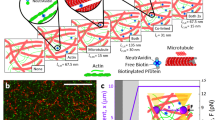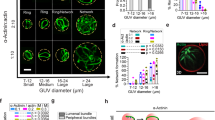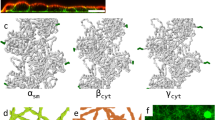Abstract
Actin filament networks with protein crosslinks of distinct length and flexibility resemble liquid crystal elastomers. We simulate actin filament systems with flexible crosslinkers of varying length and connectivity to understand general phase behaviour and elasticity. Simulated networks with very short filaments and long crosslinkers resemble the cytoskeleton of the red blood cell and remain isotropic in compression and shear, seeming well-suited to blood flow. In contrast, networks with longer filaments as found in many cell types show three regimes of nematic phase behaviour dependent on crosslinker length: (1) ‘loose’ networks are isotropic at zero stress but align under compression or shear; (2) ‘semi-loose’ networks are nematic at low stress but become isotropic under dilation and (3) ‘tight’ networks possess a locked-in nematic order as represented by the cytoskeleton of the outer hair cell in the ear, for which anisotropic compliance directs sound propagation. Furthermore, for a subset of loose networks with ‘periodic’ connections among filaments, extremely soft stress–strain behaviour is found, as predicted for liquid crystal elastomers.
This is a preview of subscription content, access via your institution
Access options
Subscribe to this journal
Receive 12 print issues and online access
$209.00 per year
only $17.42 per issue
Buy this article
- Purchase on Springer Link
- Instant access to full article PDF
Prices may be subject to local taxes which are calculated during checkout





Similar content being viewed by others
References
Keller, M., Tharmann, R., Dichtl, M. A., Bausch, A. R. & Sackmann, E. Slow filament dynamics and viscoelasticity in entangled and active actin networks. Phil. Trans. R. Soc. Lond. Ser. A 361, 699–711 (2003).
Uhde, J., Keller, M., Sackmann, E., Parmeggiani, A. & Frey, E. Internal motility in stiffening actin–myosin networks. Phys. Rev. Lett. 31, 268101 (2004).
Wang, K., Ash, J. F. & Singer, S. J. Filamin, a new high-molecular-weight protein found in smooth-muscle and non-muscle cells. Proc. Natl Acad. Sci. USA 72, 4483–4486 (1975).
Speicher, D. W. & Marchesi, V. T. Erythrocyte spectrin is comprised of many homologous triple helical segments. Nature 311, 177–180 (1984).
Byers, T. J. & Branton, D. Visualization of the protein associations in the erythrocyte-membrane skeleton. Proc. Natl Acad. Sci. USA 82, 6151–6157 (1985).
Debreuil, R., Byers, T. J., Branton, D., Goldstein, L. S. & Kiehart, D. P. Drosophila spectrin 2. conserved feaures of the alpha-subunit are revealed by analysis of cDNA clones and fusion proteins. J. Cell Biol. 105, 2095–2102 (1987).
Welch, M. D., Holtzman, D. A. & Drubin, D. G. The yeast actin cytoskeleton. Curr. Opin. Cell Biol. 6, 110–119 (1994).
Holley, M. C. & Ashmore, J. F. A cytoskeletal spring in cochlear outer hair-cells. Nature 335, 635–637 (1988).
Wada, H. et al. Imaging of the cortical cytoskeleton of guinea pig outer hair cells using atomic force microscopy. Hearing Res. 187, 51–62 (2004).
Borukhov, I., Bruinsma, R. F., Gelbart, W. M. & Liu, A. J. Structural polymorphism of the cytoskeleton: a model of linker-assisted filament aggregation. Proc. Natl Acad. Sci. USA 102, 3673–3678 (2005).
Wilhelm, J. & Frey, E. Elasticity of stiff polymer networks. Phys. Rev. Lett. 91, 108103 (2003).
Head, D. A., Levine, A. J. & MacKintosh, F. C. Distinct regimes of elastic response and deformation modes of cross-linked cytoskeletal and semiflexible polymer networks. Phys. Rev. E 68, 061907 (2003).
Gardel, M. L. et al. Elastic behavior of cross-linked and bundled actin networks. Science 304, 1301–1305 (2004).
Wong, G. C. et al. Lamellar phase of stacked two-dimensional rafts of actin filaments. Phys. Rev. Lett. 91, 018103 (2003).
Wagner, B., Tharmann, R., Haase, I., Fischer, M. & Bausch, A. R. Cytoskeletal polymer networks: The molecule structure of cross-linkers determines macroscopic properties. Proc. Natl Acad. Sci. USA 103, 13974–13978 (2006).
Warner, M. & Terentjev, E. M. Liquid Crystal Elastomers 1st edn (Oxford Univ. Press, Oxford, 2003).
Golubovic, L. & Lubensky, T. C. Nonlinear elasticity of amorphous solids. Phys. Rev. Lett. 63, 1082–1085 (1989).
Warner, M., Blandon, P. & Terentjev, E. M. Soft elasticity—Deformation without resistance in liquid-crystal elastomers. J. Phys. II (France) 4, 93–102 (1994).
Olmsted, P. D. Rotational invariance and Goldstone modes in nematic elastomers and gels. J. Phys. II (France) 4, 2215–2230 (1994).
Lubensky, T. C., Mukhopadhyay, R., Radzihovsky, L. & Xing, X. Symmetries and elasticity of nematic gels. Phys. Rev. E 66, 0112095 (2002).
Discher, D. E., Boal, D. H. & Boey, S. K. Phase transitions and anisotropic responses of planar triangular nets under large deformation. Phys. Rev. E 55, 4762–4772 (1997).
Boey, S. K., Boal, D. H. & Discher, D. E. Simulations of the erythrocyte cytoskeleton at large deformation. I. Microscopic models. Biophys. J. 75, 1573–1583 (1998).
Boal, D. H. Computer-simulation of a model network for the erythrocyte cytoskeleton. Biophys. J. 67, 521–529 (1994).
Tolomeo, J. A., Steele, C. R. & Holley, M. C. Mechanical properties of the lateral cortex of mammalian auditory outer hair cells. Biophys. J. 71, 421–429 (1996).
Pollard, T. D. & Borisy, G. G. Cellular motility driven by assembly and disassembly of actin filaments. Cell 112, 453–465 (2003).
Otomo, T. et al. Structural basis of actin filament nucleation and processive capping by a formin homology 2 domain. Nature 433, 488–494 (2005).
Bates, M. A. & Frenkel, D. Phase behavior of two-dimensional hard rod fluids. J. Chem. Phys. 112, 10034–10041 (2000).
Carlsson, A. E. Structure of autocatalytically branched actin solutions. Phys. Rev. Lett. 92, 238102 (2004).
Carlsson, A. E. The effect of branching on the critical concentration and average filament length of actin. Biophys. J. 89, 130–140 (2005).
Lee, J. C.-M. & Discher, D. E. Deformation-enhanced fluctuations in the red cell skeleton with theoretical relations to elasticity, connectivity, and spectrin unfolding. Biophys. J. 81, 3178–3192 (2001).
Picart, C., Dalhaimer, P. & Discher, D. E. Actin protofilament orientation in deformation of the erythrocyte membrane skeleton. Biophys. J. 79, 2987–3000 (2000).
Kosterlitz, J. M. & Thouless, D. Ordering, metastability and phase-transitions in 2 dimensional systems. J. Phys. C 6, 1181–1203 (1973).
Amann, K. J. & Pollard, T. D. Direct real-time observation of actin filament branching mediated by Arp2/3 complex using total internal reflection fluorescence microscopy. Proc. Natl Acad. Sci. USA 98, 15009–15013 (2001).
Noguchi, H. & Gompper, G. Shape transitions of fluid vesicles and red blood cells in capillary flows. Proc. Natl Acad. Sci. USA 102, 14159–14164 (2005).
Picart, C. & Discher, D. E. Actin protofilament orientation at the erythrocyte membrane. Biophys. J. 77, 865–878 (1999).
Hu, K., Ji, L., Applegate, K. T., Danuser, G. & Waterman-Storer, C. M. Differential transmission of actin motion within focal adhesions. Science 315, 111–115 (2007).
Disch, S., Schmidt, C. & Finkelmann, H. Nematic elastomers beyond the critical point. Macromol. Rapid. Commun. 15, 303–310 (1994).
Holmes, K. C., Popp, D., Gebhard, W. & Kabsch, W. Atomic model of the actin filament. Nature 347, 44–49 (1990).
Holley, M. C. & Ashmore, J. F. Spectrin, actin and the structure of the cortical lattice in mammalian cochlear outer hair-cells. J. Cell Sci. 96, 283–291 (1990).
Acknowledgements
Support from Penn’s NSF-MRSEC and from NIH and NSF grants is gratefully acknowledged.
Author information
Authors and Affiliations
Contributions
P.D., D.E.D. and T.C.L. designed the research problem and wrote the manuscript; P.D. wrote and conducted the simulations.
Corresponding authors
Ethics declarations
Competing interests
The authors declare no competing financial interests.
Supplementary information
Rights and permissions
About this article
Cite this article
Dalhaimer, P., Discher, D. & Lubensky, T. Crosslinked actin networks show liquid crystal elastomer behaviour, including soft-mode elasticity. Nature Phys 3, 354–360 (2007). https://doi.org/10.1038/nphys567
Received:
Accepted:
Published:
Issue Date:
DOI: https://doi.org/10.1038/nphys567
This article is cited by
-
Material approaches to active tissue mechanics
Nature Reviews Materials (2018)
-
Role of band 3 in the erythrocyte membrane structural changes under thermal fluctuations –multi scale modeling considerations
Journal of Bioenergetics and Biomembranes (2015)
-
Actin Cortex Rearrangement Caused by Coupling with the Lipid Bilayer-Modeling Considerations
The Journal of Membrane Biology (2015)
-
Assembly kinetics determine the architecture of α-actinin crosslinked F-actin networks
Nature Communications (2012)
-
Computational Analysis of a Cross-linked Actin-like Network
Experimental Mechanics (2009)



